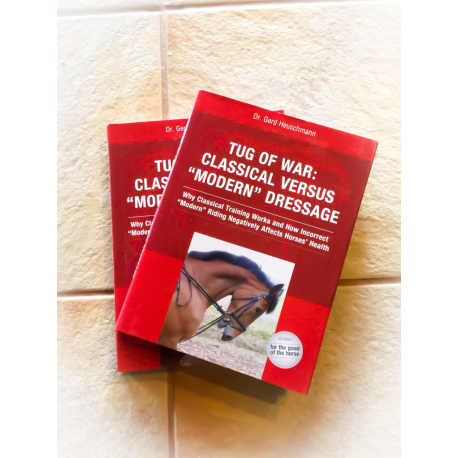Tug Of War: Classical versus “Modern” Dressage
Tug Of War: Classical versus “Modern” Dressage
or 4 interest-free payments of $12.75 with
The book Tug of War: Classical versus Modern Dressage provides an insightful and straightforward explanation of why classical training works and how incorrect “modern” riding negatively affects horses’ physical and mental wellbeing.
Description
BOOK REVIEW by Alex Johnstone
Tug Of War: Classical versus “Modern” Dressage
By Dr Gerd Heuschmann
The book Tug of War: Classical versus Modern Dressage provides an insightful and straightforward explanation of why classical training works and how incorrect “modern” riding can negatively affect the horses’ physical and mental wellbeing.
The author of the book, German rider and equine Veterinarian Dr Gred Heuschmann, explores both classical and modern dressage training methods, comparing and contrasting the physical and psychological effects that both training methods have on horses. Dr Gred Heuschmann highlights that in today’s success-oriented society a small cohort of the equestrian world are no longer motivated by their love of these magnificent creatures and of the sport itself to work with horses, but are instead interested in using horses for performance and profit.
In most cases, this hunt for success and recognition leads “trainers” to abandoning the sport ideals and alternatively looking for whatever will produce the the most spectacular show (regardless of the detrimental effects these incorrect gaits have on the horse’s body, and furthermore the psychological stress that the horse is forced to endure in order to develop and ultimately produce such ‘flashy’ movements). I use the term “trainer” loosely, as Dr Gred Heuschmann makes evident that “in order to truely call oneself a trainer, one must be educated in the horse’s basic physiology, conformation and behaviour”. These prerequisites for being considered a horse trainer gives us, as horse riders and potentially trainers, a lot of food for thought, especially because Dr Gred Heuschmann highlights that if riders learnt to recognise and respect the horse’s physical and psychological make-up many training mistakes could be easily prevented.
Dr Gerd Heuschmann continues to explain the complex world of horse anatomy and biomechanics. He explains the horse’s anatomical and physiological characteristics in a way that is comprehensible so that riders and trainers are able apply this knowledge to their training methods. The author provides his audience with a precise and clear exposition of the general anatomy of the horse, in order for us as horse riders and trainers to be able to understand the functional anatomy of the horse.
Dr Gerd Heuschmann outlines that if we know how our horses are built (ie. how their skeletal, muscular and ligament systems work together) and also how their actions are controlled in part by instinct along with other aspects of the mind, then it only follows that we have a better understanding of how to ride and train our horses.
The author continues by addressing the misunderstood ideas about riding through exploring which types of riding are beneficial for the horses’ health, and which types cause damage. He highlights the “disastrous” effects that “insensitive” training methods often have on the development of the muscles, the relaxation of the back, the naturalness of the movement, and the health of the horse’s legs and mind.
There is a real emphasis throughout the book that one of the most common errors that dressage riders make today when training is their tendency to favour hand-dominated riding – especially when training young horses – which leads to riders riding their horses in absolute elevation. When a horse is consistently ridden like this it inevitably becomes increasingly unwilling, tense, and resistant, resulting in poor basic gaits and an uncomfortable ride. This is logical because a relaxed back is the decisive prerequisite for a natural motion sequence in all three basic gaits and for allowing the rider to sit comfortably, because the longissimus muscle is released which is impossible to achieve when a horse is ridden in absolute elevation.
After explaining the key errors of each basic gait that horses develops as a result of being ridden in an artificial head set, whereby their gaits are “disharmonious”, Dr Gerd Heuschmann concludes his book by outlining what is considered to be correct physiological training.
Shipping
Lorem ipsum dolor sit amet, consectetur adipiscing elit. Aliquam eget pellentesque orci. Curabitur diam nulla, rutrum aliquam mi vel, porttitor facilisis ipsum. Nunc vestibulum justo id ipsum dignissim, non suscipit enim consectetur. Sed dui eros, sollicitudin et dolor ac, vehicula congue lectus. Pellentesque ullamcorper, magna at interdum dapibus, ipsum libero viverra erat, non rutrum ipsum dolor sit amet nisl. Nulla lacinia rhoncus est a finibus. Duis nulla purus, sodales ac dapibus ut, tempor dapibus dui. Ut tristique erat a euismod efficitur. Nullam et luctus risus. Aenean sit amet mauris quis sem cursus dictum at ac nisi. Praesent vel ante luctus, aliquam velit sed, bibendum urna. Maecenas at tellus imperdiet, placerat magna id, tincidunt velit. Integer lobortis facilisis urna sed iaculis.
 An item was added to cart!
An item was added to cart!




